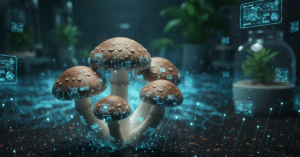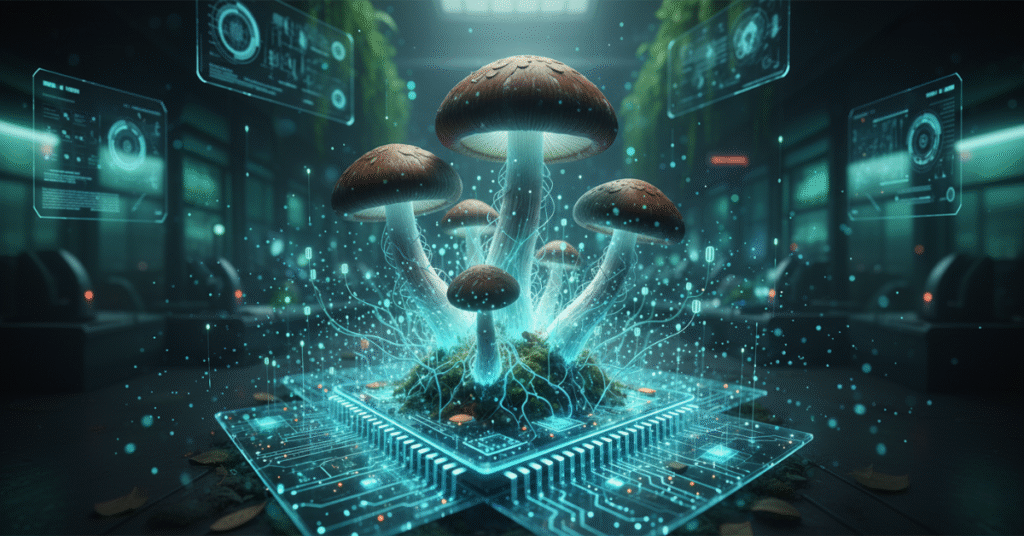The world of technology often surprises us, but few breakthroughs are as mind-bending as the recent discovery that a common fungus can be turned into a piece of a computer.
Yes, you read that right. The latest research from scientists at institutions like The Ohio State University has unveiled a revolutionary concept: the mushroom memory chip.
This isn’t science fiction; it’s the dawn of bioelectronics, where living organisms power our gadgets. As someone who constantly tracks emerging facts for FACTOVATE, I can tell you this fact is a game-changer.
It’s not just about a chip; it’s about shifting our thinking from metal and silicon to organic, sustainable life forms for the future of processing and memory. This discovery challenges everything we thought we knew about where our technology comes from.
The Science Behind Bioelectronics and Fungi

For decades, computers have relied on silicon chips—small, durable pieces of material that store and process information using electrical current.
The problem? Silicon mining and manufacturing are environmentally costly, and these chips eventually become e-waste. This is where fungi step in to offer a revolutionary, green solution.
Why Mushrooms are the Perfect Natural Processor

The key to this incredible breakthrough lies in the mycelium—the root-like structure of a mushroom. Mycelium acts much like a vast, interconnected neural network beneath the forest floor. It has several properties that make it an ideal candidate for computation.
Electrical Spikes: Scientists discovered that when stimulated, the mycelium generates electrical spikes. These spikes are not random; they can be interpreted as binary code—the zeros and ones that all computers use to process data.
Memory (Memristors): Researchers, specifically with edible Shiitake mushrooms, found that when they applied electrical voltages, the fungal body could “remember” the past electrical states.
These devices are called memristors (memory-resistors), which are crucial for storing information. This means the mushroom memory chip can perform the basic functions of a flash drive or a traditional memory component.
Low Energy Consumption: Unlike power-hungry silicon data centres, a fungal computer uses an incredibly low amount of energy. Fungi thrive on decomposing organic matter, making them a super energy-efficient and highly sustainable option. This is a massive win for green technology.
How Scientists are Growing the Organic Chips
The process involves carefully growing the shiitake mycelium on a substrate and then dehydrating it. This dehydration step is vital to concentrate its conductive properties.
Microelectrodes are delicately attached to this organic material, allowing scientists to precisely send and receive electrical signals.
The results are astounding: the shiitake-based devices demonstrated a high accuracy rate in switching between electrical states, proving their capability as a reliable mushroom memory chip.
The speed is also impressive; the researchers observed switching between states at a high frequency, suggesting the fungal components could handle complex operations.
The FACTOVATE Insight: Why This Matters to You (My Experience)

In my experience of discovering and sharing facts, the best ones are those that solve a real-world problem. The invention of the mushroom memory chip addresses two colossal issues: e-waste and sustainability.
Think about the millions of tons of obsolete electronics piling up every year. Our current tech cycle is linear: make, use, and dispose of.
What if our computer components could instead be grown, used, and then composted back into the earth, completing a beautiful, natural cycle? This is the promise of bioelectronics.
The Road Ahead: Potential Applications

This technology isn’t just a lab curiosity or a simple memory solution. It opens the door to truly next-generation, environmentally-conscious applications:
- Sustainable Bio-Sensors: Imagine sensors grown directly into a building or the soil that can detect structural stress, pollution, or moisture levels and communicate the data using the fungal network.
- Self-Healing Electronics: Since mycelium can grow and self-repair itself in nature, future electronic components might also have the inherent ability to “heal” minor damage or breaks in the circuit.
- Low-Cost Computing: Fungi are abundant, easily cultivated, and inexpensive to process, dramatically reducing the cost of manufacturing sophisticated electronics compared to silicon processing.
The transition from a hard, non-biodegradable silicon chip to a fully compostable mushroom memory chip is a testament to how nature can inspire the most advanced technology. It reminds us that sometimes, the most sophisticated solutions are hidden right beneath our feet, ready to be uncovered and revolutionize the digital world. This emerging fact is a profound example of how bio-inspired technology will shape a cleaner, more efficient future.

